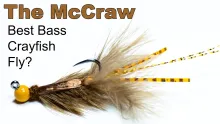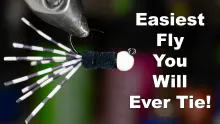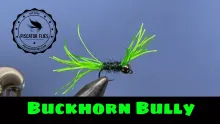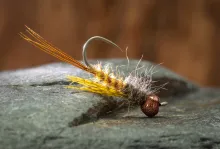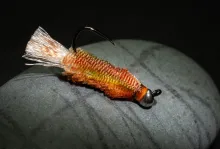This odd, multi-legged thingy named after a species found as a Cambrian fossil has a strange appeal to trout
I’ve no idea what trout take this multi-legged fly for but take it they do. Its name comes from Hallucigenia, a genus of marine worm like animals found as Cambrian age fossils in the Burgess Shales of British Columbia. I saw one of the fossils and a model twenty or so years ago in the museum in the small town of Field, BC. It looks like a worm walking on stilts.
The Hallucinator developed as a variant of an old pattern of mine, the Micro-X, which is pretty much as simple as you can get for a fly with legs. To make one just tie in a loop of legs behind the tungsten bead and dub over the threads turns before whip finishing and trimming the legs. I tie it in a range of sizes and colours and they all catch fish.
The Micro-X and the Hallucinator work in both fast water and slow water. On small rivers and streams I like to chuck them into the plunge pools of waterfalls or even cast just above the fall and let the fly slide over the edge and drop down to any fish waiting below. If there is a fish in residence the take often comes immediately. On slow pools I let them drift along the bottom while making the legs twitch with the rod tip.
While tying a Micro-X with just four legs is dead easy, tying with more legs can get to be a pain. The wriggly strands insist on getting in the way, tangling, or ending up in the wrong place. The fish probably wouldn’t care in the least, but they just don’t look good to me.
These are the type of flies that can convince us when sat at the vice that we have the wrong number of hands and fingers. They would be a lot easier to tie with three hands each with two or three fingers to hold the springy strands out of the way while wrapping other stuff around the hook.
Flies with lots of legs like Pat Bennett’s Rubber Legs, a stonefly nymph imitation from the US, are typically constructed by tying in the pairs of legs onto the hook individually with cross wraps and then wrapping chenille up the hook between and around the legs. That can be a recipe for frustration, we have insufficient hands and too many fingers. The springy legs get in the way all the time and letting go of the chenille will automatically disassemble the fly.
There is an easy way for those of us with the conventional number of hands and digits. Just tie in a bunch of legs all at once in the middle of the hook and then wind the body using a slim darning wool attached to a heavy pair of hackle pliers. That’s just how the Hallucinator is tied. Using thin darning wool rather than dubbing or chenille makes for frustration free wrapping and results in a nice slim body.
Like the Micro-X I tie Hallucinators in a variety of colour combinations of body and legs.
A side note from the editor
I have always been fascinated by the Cambrian period, and by species like Hallucigenia in particular, so this pattern truck a note with me.
I met them during my biology studies at the University of Copenhagen, and my interest was kindled by the book “Wonderful life” by Stephen Jay Gould, which I read back then and have reread many times since.
Hallucigenia lived approximately half a billion years ago during the so called Cambrian Explosion. This was an era of very rapid evolution, during which most major animal groups first appeared. Many well known fossils from that period come from the Burgess Shale in Canada's Rocky Mountains, one of the richest Cambrian fossil deposits ever found.
The period is interesting with a ton of really odd animals appearing - and some of them dying out again - among them some which you may recognize as something living now, and some so strange and out of this world that we can hardly imagine it – like the Hallucigenia, the Opabinia or the – relatively – gigantic Anomalocaris.
Below you see some reconstructions of some of the species made from the fairly well preserved fossils.
Martin
- Log in to post comments















